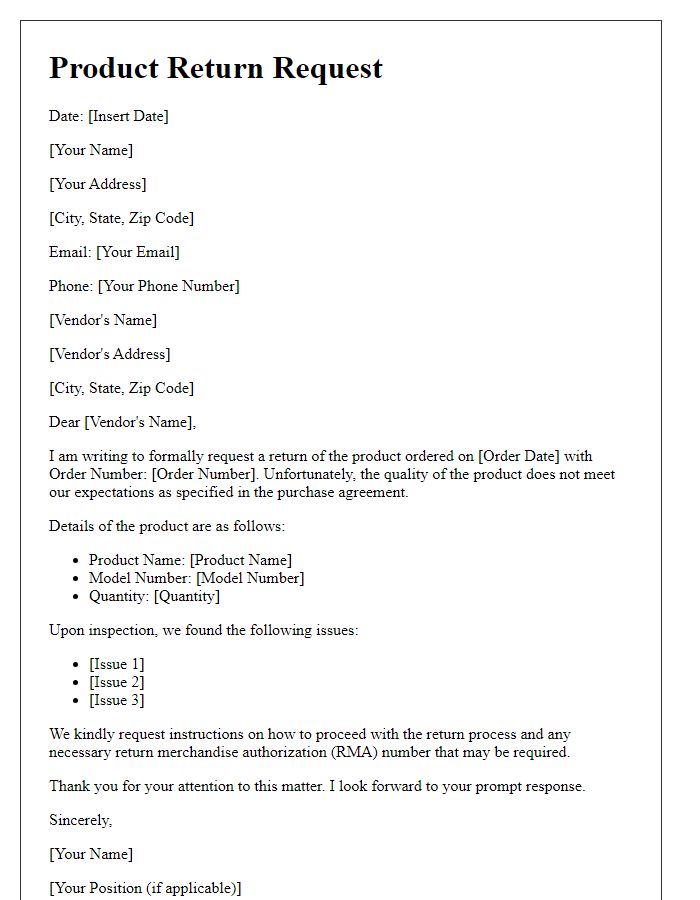Navigating product returns can often feel overwhelming, but it doesn't have to be. Whether you received an incorrect item or simply changed your mind, understanding the process can make everything simpler. In this article, we'll guide you through a clear and efficient template for requesting a product return from vendors. So, grab a cup of coffee and let's dive into the nitty-gritty of crafting your return request!

Clear Subject Line
Creating a clear subject line for a vendor product return request is essential for effective communication. A well-crafted subject line helps convey the purpose of the email immediately. Examples include "Request for Product Return Authorization - Order #12345" or "Return Request for Defective Item - Model XYZ." Including specific details like the order number or product model creates clarity and urgency, ensuring the request is prioritized. A concise subject line allows the vendor to understand the context quickly, facilitating a smoother return process and better customer service outcomes.
Vendor and Product Information
A product return request often involves essential vendor details and specific product information. Vendors, such as TechCorp or HomeGoods, may provide unique return policies that dictate the process. Product details include item description, such as a 65-inch LED television or a kitchen blender, along with identification numbers like model numbers (e.g., TCL 6-Series), prices (e.g., $599.99), and purchase dates (e.g., June 1, 2023). Documenting this information accurately ensures a smoother return process and enables efficient follow-up communications, often facilitating tracking and resolution of issues.
Reason for Return
A vendor product return request typically outlines a clear reason for the return of an item. Common reasons for returns can include defects, such as a manufacturing flaw observable in items like electronics, furniture, or clothing. Damage during shipping often requires the submission of photographic evidence to support the claim, particularly for fragile products like glassware or electronics. Incorrect items sent, such as the wrong size or model number, can cause misunderstanding, necessitating precise identification of the product's SKU (Stock Keeping Unit) for clarity. Additionally, unsatisfactory performance, such as a blender that fails to operate effectively despite following usage instructions, can warrant a return under a satisfaction guarantee policy. Each reason plays a critical role in ensuring a smooth return process, reflecting consumer rights and vendor responsibility.
Return Instructions Requested
A product return request often involves communication with vendors, detailing the need for return instructions due to issues such as defects or incorrect items received. This usually pertains to consumer goods like electronics, clothing, or appliances. For instance, an item purchased on an e-commerce platform, experiencing malfunction within 30 days of delivery, warrants initiation of the return process. Specific details such as the order number, purchase date, and a description of the product's condition must be included. This ensures a streamlined return process. Providing your contact information may expedite the vendor's response and facilitate quicker resolution.
Contact Information
Submitting a vendor product return request requires clear and concise communication. Essential components of the contact information include the vendor name, which identifies the business entity, the vendor address, providing a physical location for shipping returns, and customer service phone numbers, facilitating prompt communication regarding issues. Email addresses are also vital for digital correspondence, ensuring a paper trail for the request. Additionally, including an order number aids in tracking the specific purchase, streamlining the return process. Accurate and complete contact information is crucial for resolving any disputes efficiently.
Letter Template For Vendor Product Return Request Samples
Letter template of vendor product return request for unsatisfactory quality

Letter template of vendor product return request for wrong size or specifications

Letter template of vendor product return request for seasonal merchandise











Comments